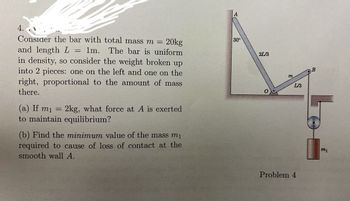Question

Transcribed Image Text:4.
20kg
Consider the bar with total mass m =
and length L = 1m. The bar is uniform
in density, so consider the weight broken up
into 2 pieces: one on the left and one on the
right, proportional to the amount of mass
there.
(a) If m₁ = 2kg, what force at A is exerted
to maintain equilibrium?
(b) Find the minimum value of the mass m₁
required to cause of loss of contact at the
smooth wall A.
A
30°
2L/3
0
m
L/3
Problem 4
B
mi
Expert Solution
This question has been solved!
Explore an expertly crafted, step-by-step solution for a thorough understanding of key concepts.
Step by stepSolved in 6 steps with 7 images

Knowledge Booster
Similar questions
- A meterstick of uniform density is hung from a string tied at the 25-cm mark. A 0.50-kg object is hung from the zero end of the meterstick, and the meterstick is balanced horizontally. What is the mass of the meterstick? (a) 0.25 kg (b) 0.50 kg (c) 0.75 kg (d) 1.0 kg (e) 2.0 kg (f) impossible to determinearrow_forwardPlease help mearrow_forwardYou are asked to construct a mobile with four equal m = 185 kg masses, and three light rods of negligible mass and equal lengths. The rods are of length 55 cm. (a) At what location on the level 1 rod should the free end of rod 2 be attached?L1 = (b) At what location on the level 2 rod should the free end of rod 3 be attached?L2 = (c) At what location on the level 3 rod should the whole assembly be suspended from so that the mobile is in equilibrium?L3 =arrow_forward
- A 11 N horizontal force F→ pushes a block weighing 4.1 N against a vertical wall (see the figure). The coefficient of static friction between the wall and the block is 0.56, and the coefficient of kinetic friction is 0.49. Assume that the block is not moving initially. (a) Will the block move? ("yes" or "no") (b) In unit-vector notation Fxî+Fyĵ, what is the force on the block from the wall?arrow_forwardIn the figure, a 110 kg uniform log hangs by two steel wires, A and B, both of radius 1.00 mm. Initially, wire A was 2.50 m long and 1.90 mm shorter than wire B. The log is now horizontal. Young's modulus for steel is 2.00 × 1011 N/m². What are the magnitudes of the forces on it from (a) wire A and (b) wire B? (c) What is the ratio dд/dB? Wire A Wire B comarrow_forwardGold, which has a density of 19.32 g/cm3, is the most ductile metal and can be pressed into a thin leaf or drawn out into a long fiber. (b) If, instead, the gold is drawn out into a cylindrical fiber of radius 2.100 μm, what is the length of the fiber?arrow_forward
- A 330 gram ball is attached to one end of a rubber (Young's Modulus= 0.120 GN/m²) wire of diameter 1.32 mm and an unstretched length of 83.0 cm. The other end of the wire is attached to the top of a post. The ball rotates around the post in a horizontal plane such that the angle between the wire and the horizontal is 10.5 degrees. Find the tension in the wire and the increase in the wire's length due to the tension in the wire. Tension = ALength cmarrow_forwardA ladder rests against a frictionless wall. It has a mass of 40 kg, a length of 6.4 m, and makes an angle of 56° with the ground. Find the horizontal and vertical force components exerted by the ground on the bottom of the ladder if a standard man stands on the ladder 4 m from the ground. (Assume the mass of the standard man is 70 kg. Enter the magnitudes in newtons.)arrow_forward
arrow_back_ios
arrow_forward_ios